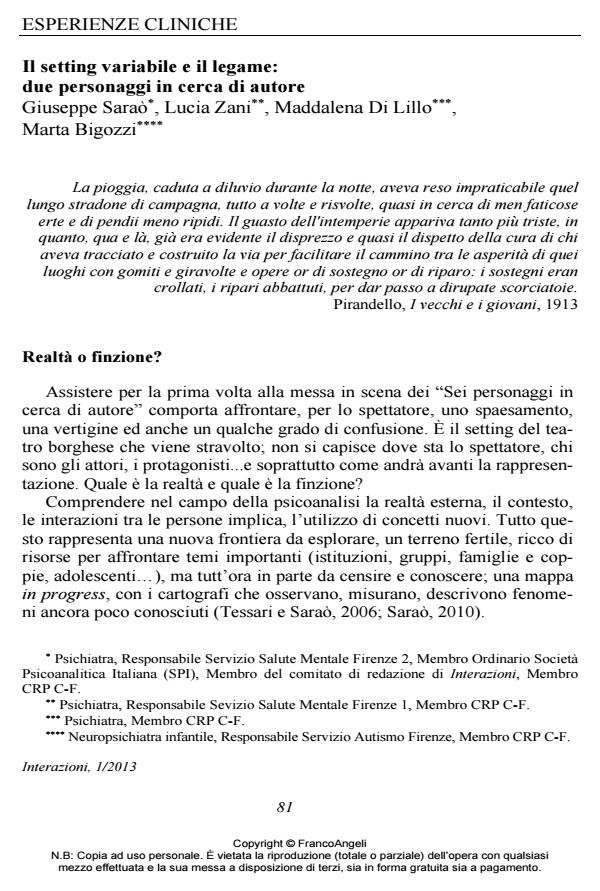The Variable Setting and the Link: two characters in search of an author
Journal title INTERAZIONI
Author/s Giuseppe Saraò, Lucia Zani, Maddalena Di Lillo, Marta Bigozzi
Publishing Year 2013 Issue 2013/1 Language Italian
Pages 12 P. 81-92 File size 394 KB
DOI 10.3280/INT2013-001006
DOI is like a bar code for intellectual property: to have more infomation
click here
Below, you can see the article first page
If you want to buy this article in PDF format, you can do it, following the instructions to buy download credits

FrancoAngeli is member of Publishers International Linking Association, Inc (PILA), a not-for-profit association which run the CrossRef service enabling links to and from online scholarly content.
The significance of the setting in the treatment of serious patients, adolescents, couples and especially families, has in recent years assumed great centrality. A background that fosters the therapeutic process is transformed into added value. In particular, we focus on the frame of the setting, not only with respect to the sediment which is naturally conveyed in any therapy, but especially at the boundaries when it is desirable and necessary to change the setting. The so-called variable setting requires of the therapist both attentive maintenance and a rigorous internal setting. We move into an insidious territory but one with great prospects and developments. This involves exploring other possible settings within that therapeutic process. This perspective is less dangerous and "wild" if in this move on the edge of the frame, we rely on the concept of intersubjective link, in the meaning given by Kaës: "the specific unconscious psychic reality built by two or more subjects". It is the psychopathology of the bond that represents a possible compass with which to navigate, especially in those complex clinical situations where there is a real risk not of a temporary impasse, but of transforming a time-limited process to an endless relationship. In this direction, the frame of the setting is transformed from a powerful factor of stability, to an ambiguous border, a rift in search of meaning, a talking through the setting, a proposing, by the therapist, other configurations of meanings and possible relationships, expecting the reemergence of new areas of symbolization.
Keywords: Setting, link, variable setting, therapeutic impasse, ambiguity in the setting
- AA.VV. (1992). Legami e affetti. Interazioni, 0: 7-ss.
- AA.VV. (1994). Coniugalità e genitorialità. Interazioni, 4: 7-ss. AA.VV. (2006). Complesso fraterno e complesso edipico. Interazioni, 25: 7-ss.
- AA.VV. (2008). Soggettività in relazione, dialogo tra modelli nella psicoanalisi nord-americana. Interazioni, 30: 7-ss.
- AA.VV. (2011). Il legame, un nuovo concetto per la cura. Interazioni, 33: 7-ss.
- Berenstein I. (2000). El vinculo y el otro. Rev. de Psicoanalisis, LVII, 3-4: 677-688.
- Berenstein I. (2004). El sujeto como otro(inter)otros. Bueno Aires: Lugar.
- Bleger J. (1967). Simbiosi e ambiguità. Roma: Armando, 2000.
- Bordi S. (2005). Transfert e intersoggettività. Centro Milanese di Psicoanalisi, letto l’11 novembre 2005.
- Bromberg P.M. (1998). Clinica del trauma e della dissociazione. Standing in the spaces. Milano: Raffaello Cortina, 2007.
- Clulow C. (2001). Attaccamento adulto e psicoterapia di coppia. Roma: Borla, 2003.
- Correale A. (2006). Area traumatica e campo istituzionale. Roma: Borla.
- Dicks H. (1967). Tensioni coniugali. Roma: Borla, 1991.
- Eiguer A. (2008). Mai io senza di te: psicoanalisi dei legami intersoggettivi. Roma: Borla, 2010.
- Erikson E. (1968). Gioventù e crisi di identità. Roma: Armando Editore, 1974.
- Kaës R. (2009). Le alleanze inconsce. Roma: Borla, 2010.
- Kaës R.(2010). Il lavoro dell’inconscio in tre spazi della realtà psichica. Un modello della complessità. Rivista di Psicoanalisi, 56: 671-685.
- Losso R. (2000). Psicoanalisi della famiglia, percorsi teorici-clinici. Milano: Franco Angeli, 2000.
- Nicolò A.M. (2002). La violencia en la pareia. In Pèrez-Testor C., Alomar Kurz E. (eds.), Violencia en la familia. Barcellona: Edebé, 2005.
- Nicolò A.M. (2006). Folie à Deux as a Model for Transpersonal Disorders. In Scharff J.S., Scharff D.E. (eds.), New Paradigms for Treating Relationships. Lanham: Jason Aronson.
- Ogden T. (1994). The analytic third: working in inter-subjective clinical facts. Intenational Journal of Psycoanalysis, 75: 3-11. DOI 10.1111/j.1752-0118.1994.tb00718.x.
- Pichon-Rivière E. (1979). Teoria del vinculo. Buenos Aires: Nueva Vision.
- Racamier P.C. (1992). Il genio delle origini. Psicoanalisi e psicosi. Milano: Raffaello Cortina, 1993.
- Ruszczynski S., Fisher J. (a cura di) (1995). Intrusività ed intimità. Roma: Borla, 2003.
- Saraò G. (2010). Vecchie e nuove patologie nella coppia e nella famiglia. Letto al congresso “Famiglie in trasformazione: una sfida per la psicoterapia psicoanalitica”, Firenze, 21-23 maggio 2010.
- Siegel D.J. (2003). How we disconnect and reconnect. Repture and repair. In Siegel D.J., Hatzell M., Parenting from inside out. New York: Penguin Group.
- Storolow R., Atwood G. (1992). I contesti dell’essere. Le basi intersoggettive della vita psichica. Torino: Bollati Boringhieri, 1995.
- Tessari G., Saraò G. (2006). Le terre di mezzo, il difficile confine tra la genitorialità e la funzione fraterna. Interazioni, 1: 71-85.
- Tronick E.Z. (2005). Why is connection with other so critical? The formation of dyadic state of consciousness and the expansion of individual’s state of consciousness. Coherence governed selection and co-creation of meaning out of messy meaning. In Nadel J.e Muir (a cura di), Emotional Development. Oxford: Oxford Univesity Press.
- Velotti P., Zavattini G.C. (2011). Attaccamento adulto e relazione di coppia, schemi del passato e disconnessioni del presente. www.psiche-spi.it
- Editoriale Giuseppe Saraò, Giacomo Tessari, in INTERAZIONI 1/2018 pp.7
DOI: 10.3280/INT2018-001001
Giuseppe Saraò, Lucia Zani, Maddalena Di Lillo, Marta Bigozzi, Il setting variabile e il legame: due personaggi in cerca di autore in "INTERAZIONI" 1/2013, pp 81-92, DOI: 10.3280/INT2013-001006